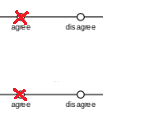Bias > Acquiescence Bias
What is Acquiescence Bias?
 Acquiescence bias is the tendency for people to agree rather than disagree. This happens when a question is posed with unbalanced answers like agree/disagree or yes/no. It is a common form of measurement error in surveys and when it happens, it has substantial effects.
Acquiescence bias is the tendency for people to agree rather than disagree. This happens when a question is posed with unbalanced answers like agree/disagree or yes/no. It is a common form of measurement error in surveys and when it happens, it has substantial effects.
Acquiescence bias isn’t limited to people just feeling more inclined to say yes. Another form of this bias is more subtle; People tend to agree with a statement worded like “Do you agree or disagree” and they tend to disagree when presented with the opposite form — “Do you disagree or agree”.
Why Does This Bias Happen?
Some researchers think this type of bias is due to politeness because people tend to agree (to be polite) unless they have very strong negative feelings about a topic. It also happens when a person defers to a higher authority — like an interviewer, who the interviewee thinks is more knowledgeable or intelligent, or is of a higher social class. Finally, respondents may just want to “get it over with” and answer “agree” to speed up the process. Faced with a lengthy quiz they don’t want to take, people will check “agree” down the block without even fully reading the questions.
How to Avoid This Type of Bias
The solution to avoiding acquiescence bias is to not ask questions with an agree/disagree choice in the first place. Although they are easy to administer, takes less time, and elicit fewer “I don’t know” responses than construct specific questions, they do open the survey up to a significant amount of bias which results in lower quality data.
References
Moss, Simon. (2008). Acquiescence bias. Retrieved July 9, 2020 from: https://web.archive.org/web/20110218193248/http://www.psych-it.com.au/Psychlopedia/article.asp?id=154
Sauro, J. (2016). Quantifying the User Experience: Practical Statistics for User Research 2nd Edition. Moragn Kaufmann.
Watson, Dorothy (1992). “Correcting for Acquiescent Response Bias in the Absence of a Balanced Scale: An Application to Class Consciousness”. Sociological Methods & Research 21 (1): 52–88. doi:10.1177/0049124192021001003.